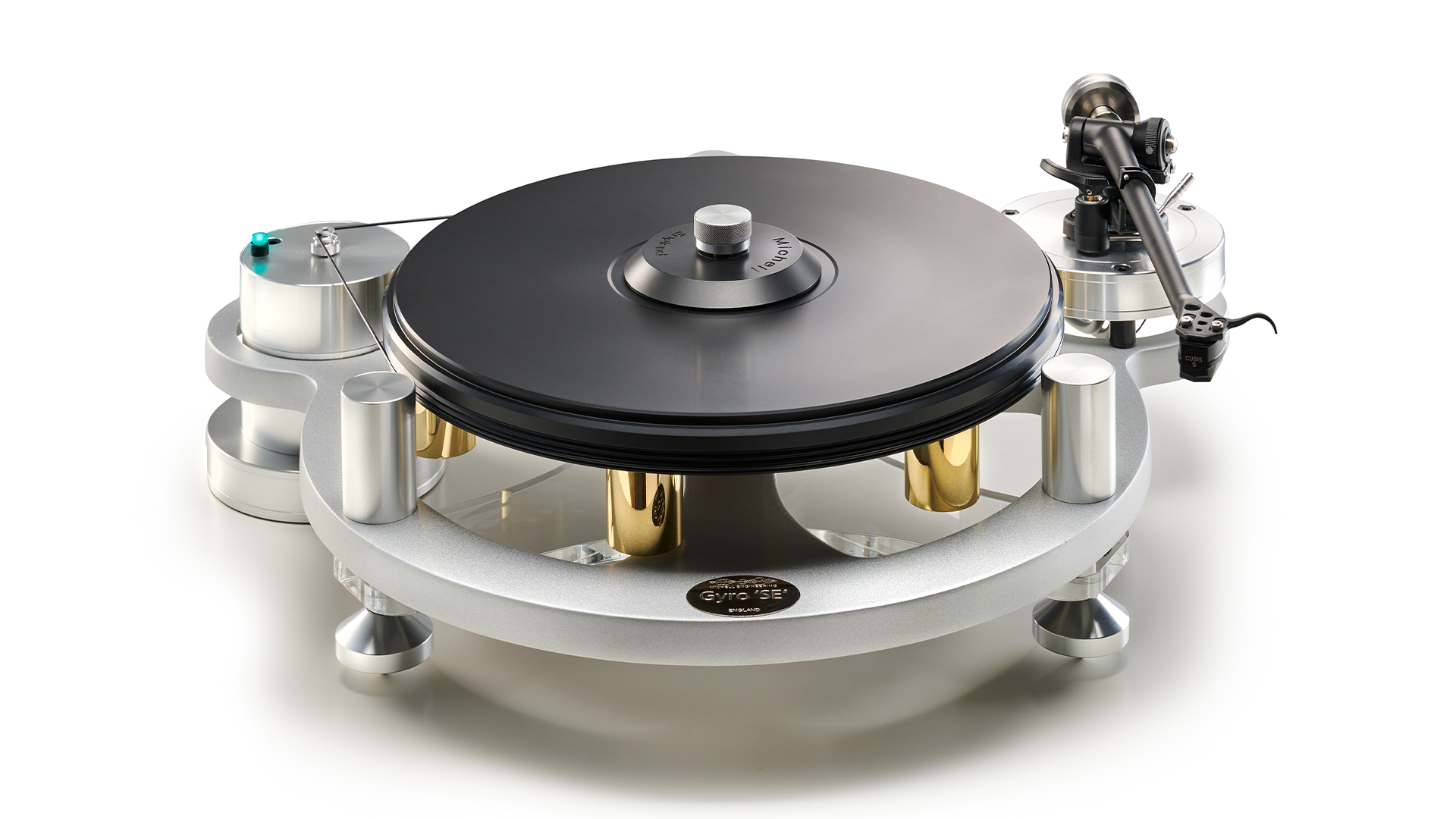
Chances are, you’ve seen a Michell GyroDec turntable before. The iconic turntable from the 1980s, with its spinning brass weights in a suspended design and distinctive engineering remains, even today, a hallmark of British turntable design. You’ve probably seen it in films. At trade shows or in magazines. Steve Jobs had one.
The classic Michell GyroDec has been in production since the 1980s, but nearly every element – from power supply to platter – has been redesigned to a more sophisticated level over the years. The model we have on test here is the Michell Gyro SE. ‘SE’ Stands for ’Spider Edition’ and instead of the full-sized, rectangular plinth (‘deck’) design seen in the standard GyroDec model, this more compact and more affordable Gyro SE uses a three-point acrylic ‘spider’ plinth to support the sub-chassis. Michell says the Gyro SE has become the company’s best-selling turntable.
Price & configuration
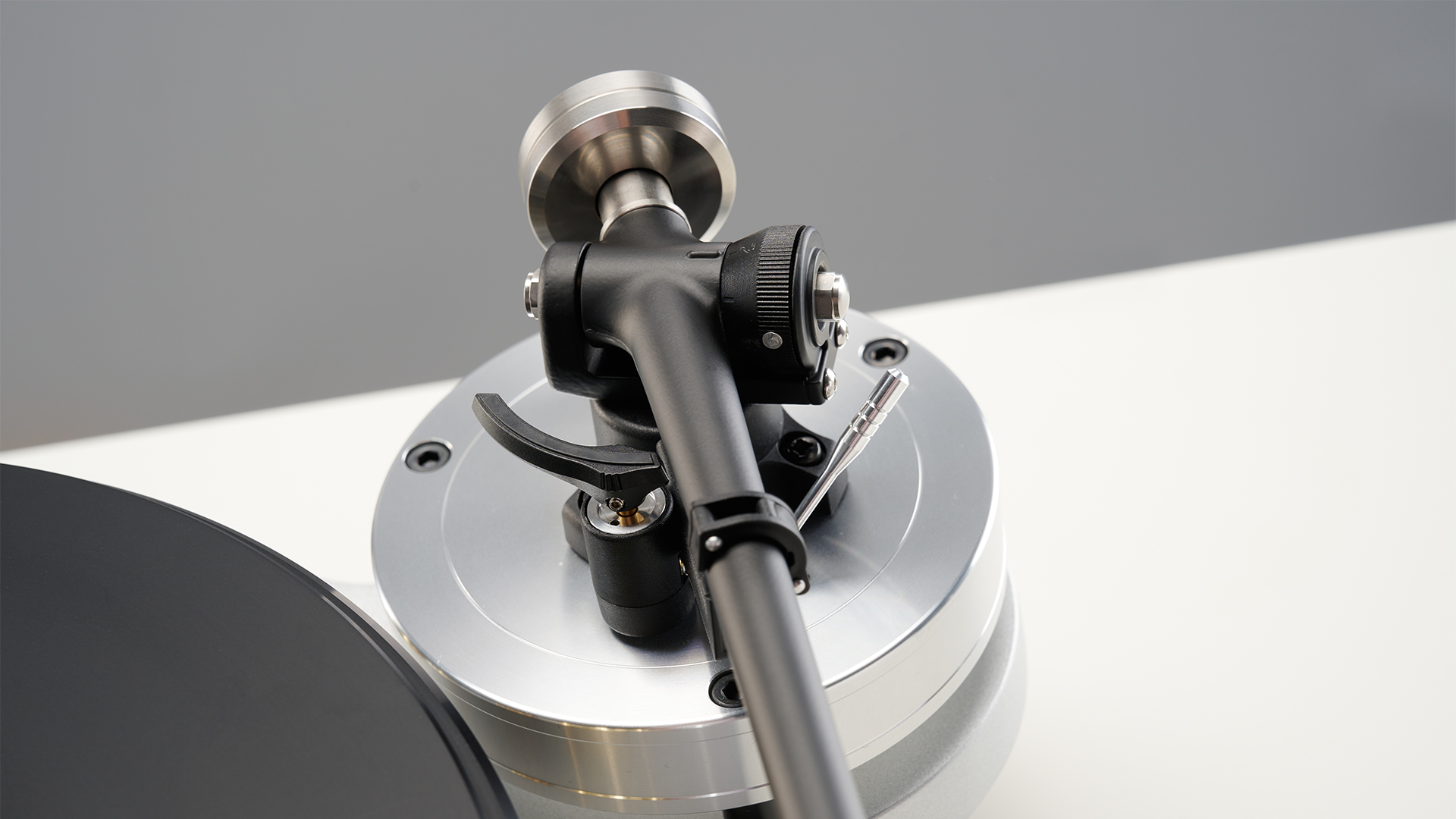
You can buy the Gyro SE on its own for £3500 (approx. $5299 / AU$8100), but we would recommend adding the tonearm and cartridge as part of the package, as not only do they come pre-fitted, but they are designed to work well together. The turntable itself will need assembling by your own hands at home – more on this later – but we would leave the tougher job of fitting the tonearm to the mount to Michell.
Our review sample comes fitted with Michell’s T8 tonearm and Cusis S MC cartridge – both effectively the mid-range options of Michell’s offerings. The Cusis S moving coil cartridge costs £1500 / $1999 / AU$3470 on its own; it comes housed in an aluminium body, features a boron cantilever and a ‘Shibata’ stylus, with a recommended 2g tracking force. Michell says the Cusis S’s construction and materials have been meticulously designed to reduce unwanted resonances. The T8 tonearm is made specifically for Michell’s turntables and can’t be bought separately. Turntable aficionados might recognise that the tonearm is made by Rega and, as is usual, the design consists of a one-piece arm tube. This model has an updated aluminium bearing housing, with a stainless steel sleeve and vertical bearing shaft. These all add up to a more stable and rigid arm that gives a good foundation for the cartridge to work from. High quality phono wires and phono plugs are used; a sturdy aluminium counterweight is included.
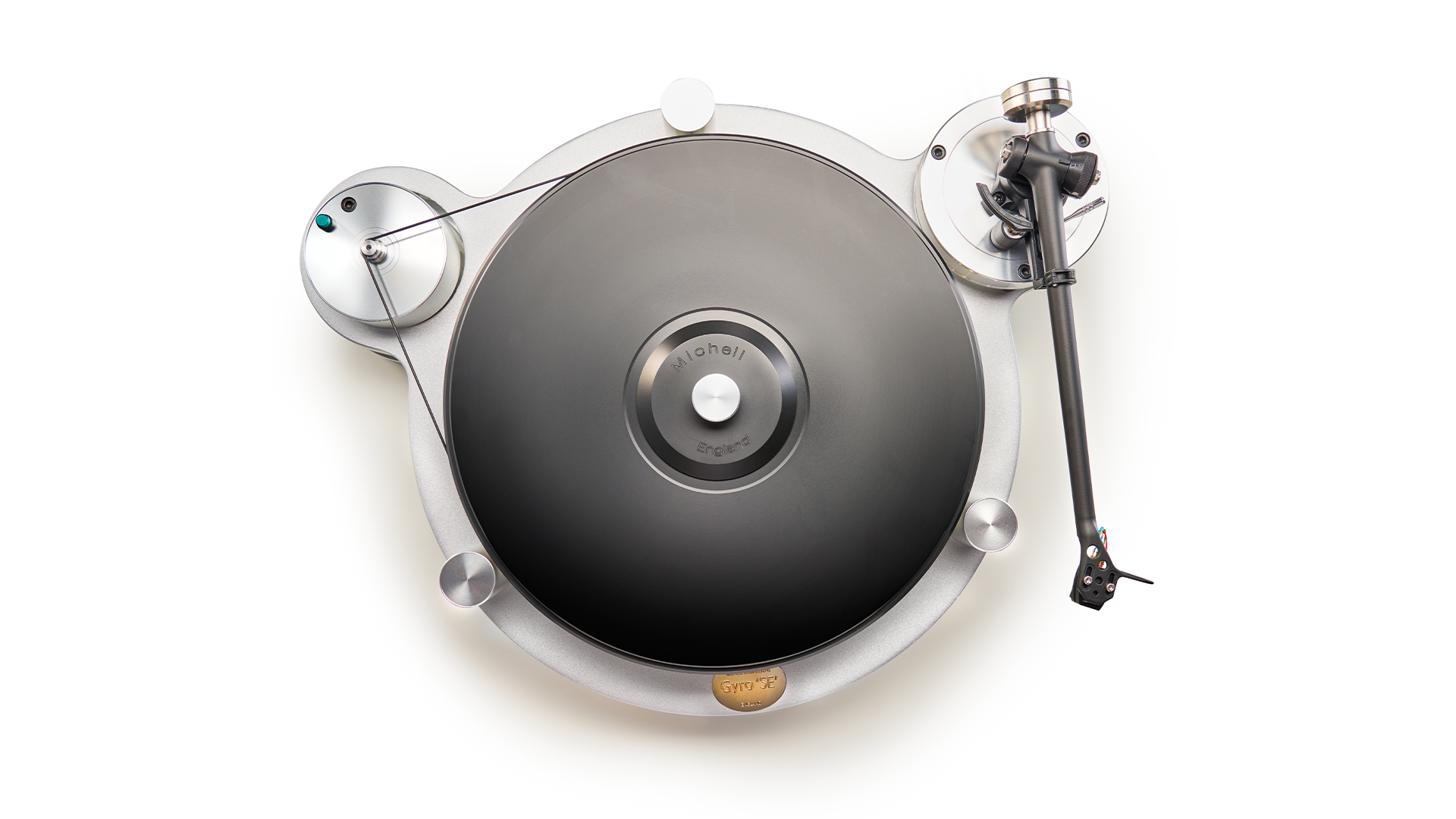
Type Belt drive
Operation Manual
Speeds 33⅓, 45 rpm
Speed change Manual
Cartridge Cusis C (MC)
Phono stage? No
Bluetooth? No
USB? No
Dimensions (hwd) 13.5 x 49 x 37.5cm
Weight 10kg
Finishes x 2 (silver, black)
Altogether, the Gyro SE turntable with the Cusis S MC cartridge and T8 tonearm can be yours for the package price of £6800 in the UK. This includes the ‘unicover’ dust lid, a record clamp, and all the accessories you need to assemble the turntable at home. Note that the cartridge and tonearm combination prices will vary in other territories, so you’ll have to add up the prices of each component. As a rough guide, the US price for this combination is about $8498, while the Australian price is between AU$12,000 and AU$13,200.
It’s worth mentioning the other accessories you can buy to further enhance the Gyro SE’s performance. You can swap out the standard feet for the LEVIS Magnetic Levitation feet (£460 / $749 / AU$1240 approx. for a set of three), which uses opposing magnets in the construction for even greater isolation from minute vibrations affecting the deck’s replay. It’s simple enough to unscrew the standard feet of the turntable and screw on these magnetic feet, and the overall performance will sound more solid and have more grip in the low end.
The one upgrade we would seriously consider is the external HR Power Supply that delivers a cleaner, low-noise feed to the turntable’s motor. It’s costly at £800 ($999 / AU$1850), but its impact on the Gyro SE’s performance is significant. We swapped out the turntable’s standard power supply for the HR upgrade during our review and the effect was immediate: more authority, more muscle, more solidity. The HR Power Supply also usefully adds in electronic speed change for the otherwise fully manual record player.
Design & build
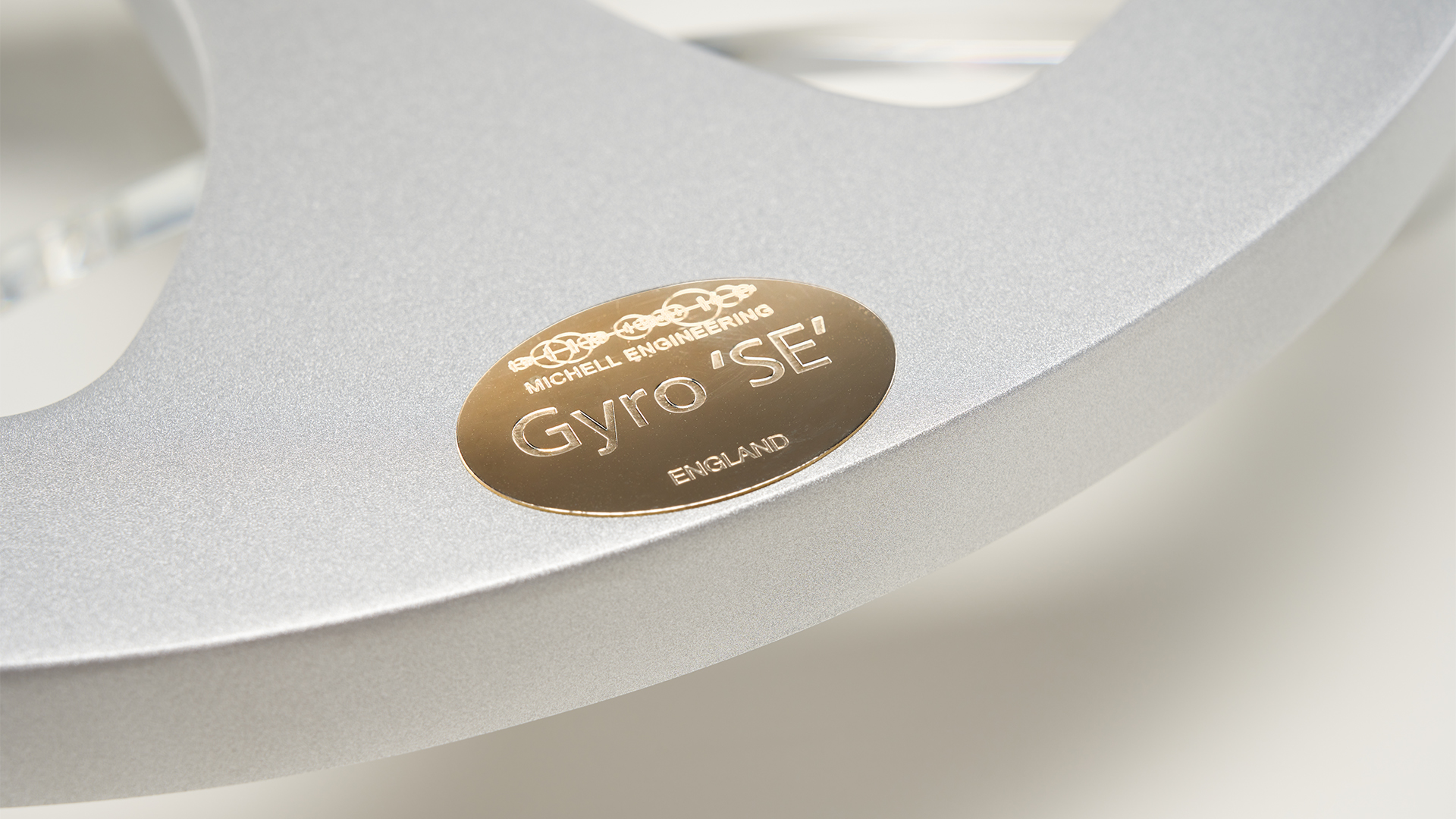
The principles of the Gyro design have remained the same: belt drive design with isolated motor, hanging weights on the platter, and a spring suspension system. The advantage of a suspended design is to keep unwanted external vibrations away from the cartridge/record interface, and every decision made in the Michell’s design is largely to prevent any such detrimental effects on the very precise job of the stylus accurately reading the information stored in the record groove.
The materials and machining processes have evolved over the years, and the general build of the Gyro SE is of a high quality for this level. All the mechanical parts – from the aluminium sub-chassis structure to the springs, from the brass weights to the main bearing – feel wonderfully smooth and finished to a meticulous degree. It remains a beautifully-made and beautiful-looking turntable.
At the heart of the Gyro’s design is the three-point suspension system, whereby the sub-chassis is suspended upon three springs that are fixed to the clear acrylic plinth. This comes semi-assembled; you can adjust the height of the sub-chassis by turning the springs.
The heavy motor unit is completely separate from the main body of the turntable, to further prevent any noise and vibrations when the motor is running from reaching the deck. The only contact point between the motor and turntable is the belt – loop it around the motor pulley and the last groove on the platter. At this price, we would’ve expected electronic speed change as standard. Still, it’s not too much of a fuss to change the speed manually on the deck; you have to move the belt to the second groove on the motor pulley to play 45 rpm records.
The main bearing of the Gyro SE is an inverted design, and it is a self-lubricating design that draws oil from a reservoir at the base of the main bearing up to a thrust ball at the top. The oil then returns to the reservoir thanks to a hole drilled into the bearing spindle. It’s an effective system and the bearing is exquisitely machined. The main bearing housing is made of the highest-grade brass, while the shaft is carbon steel.
Rounding things off is the heavy platter, which is made of a material called Delrin and chosen for its inert nature and impedance properties that are similar to vinyl, with the aim of getting a more neutral sound. The record clamp that comes as standard is sturdy and easy to operate; nothing catastrophic will happen if you forget to clamp down your records every time, but make sure you do so for better focus and solidity.
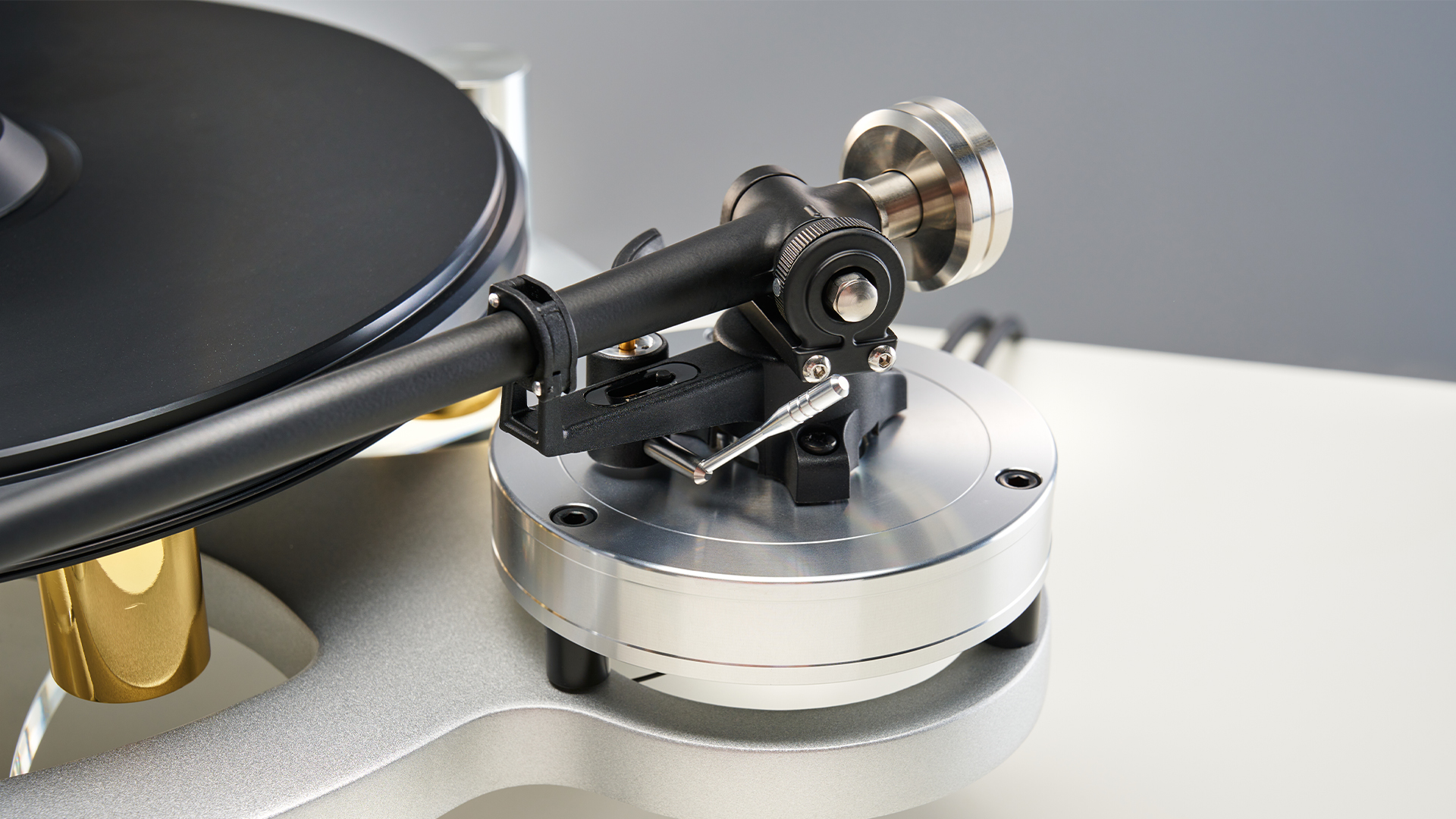
Of course, it wouldn’t be a Gyro turntable without the solid brass weights that hang under the platter to help improve speed stability in this belt-drive design. The six brass weights are evenly spaced out and add extra mass to the platter, giving it more momentum when spinning. We know the Michell’s aesthetic won’t be for everyone; however, it is utterly mesmeric watching the brass weights spin. It’s a unique design point that, no matter how many times we’ve seen it over the years, remains a rather enchanting effect.
The Gyro SE comes in two finishes – silver and black – but the brass weights’ gold-plated colour remains in either option. Some on our review team find that this clashes with the silver aluminium sub-chassis finish, with the all-black finish offering a cleaner contrast instead. The choice is entirely yours.
And finally, the three feet under the acrylic plinth are made of solid aluminium, and are designed so that they have as little surface area in contact with the support furniture the Gyro is placed on, so that very little vibration is transferred to the deck.
Assembly & set-up
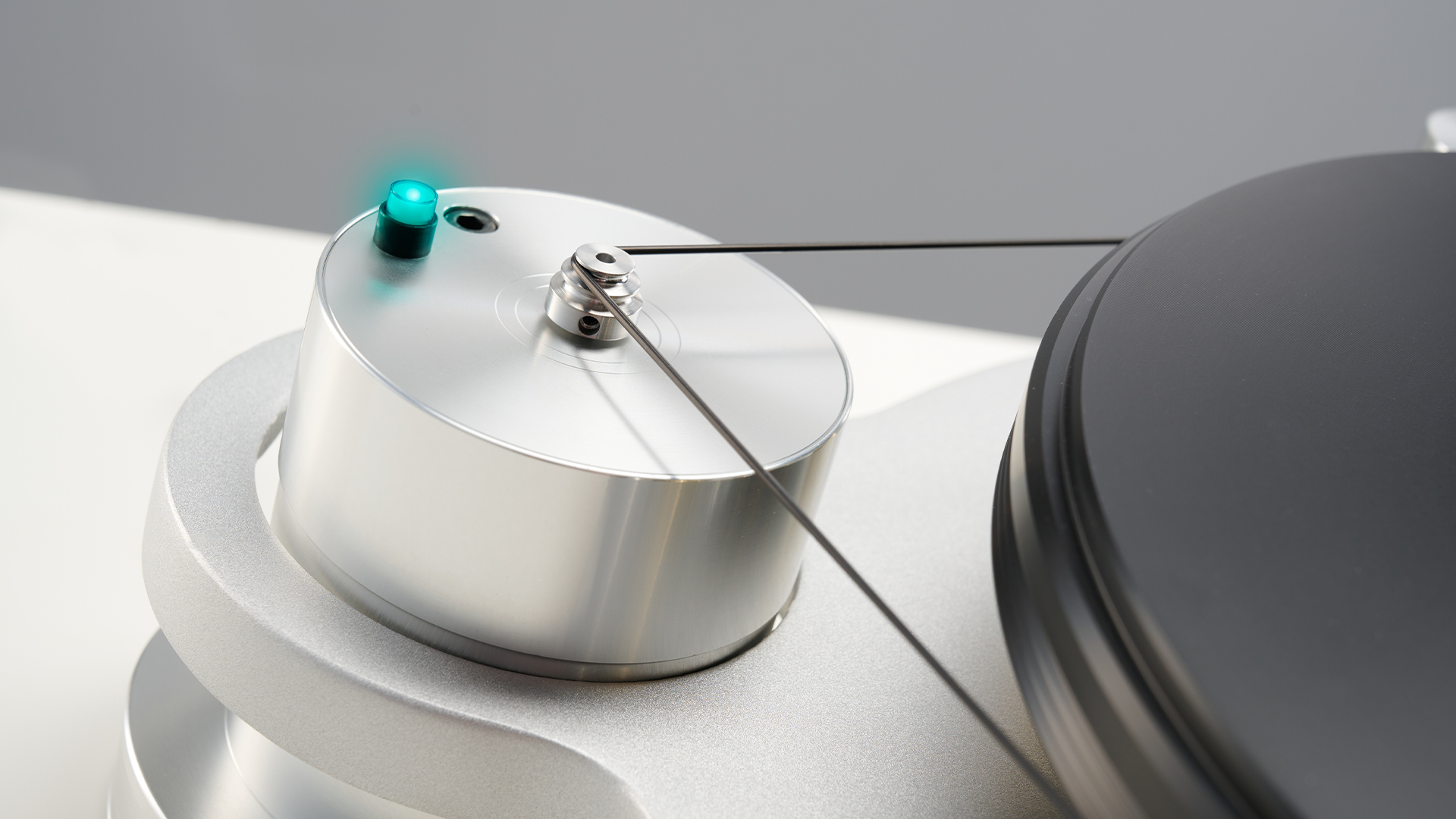
An integral part of the experience of owning a Michell turntable is that you get to assemble the turntable yourself. While other brands such as Linn will require a specialist dealer with the right tools and skills (and patience) to set up an LP12, the Gyro SE is more user-friendly. You can ask a dealer to set it up if you prefer, but we think assembling the Gyro yourself is all part of the fun, and offers you a level of tactility and connection with your turntable that you just don’t get with most other hi-fi products.
The way the Gyro SE is packed and presented has been considerably improved compared with the last time we tested a Michell (the Gyrodec SE/TecnoArm A back in 2008). The included booklet has been updated with images, making the step-by-step instructions far clearer and easier to follow during set-up. We would set aside a good chunk of time to assemble the Gyro, and it is hugely rewarding at the end once you’ve oiled the bearing, twisted the springs to the right height levels, checked it’s all level with a bubble level, and everything is spinning correctly. While the initial prospect of assembling such a delicate piece of hi-fi feels daunting, we soon realise just how precisely built every moving part of the turntable is, and we find everything slots into place in a way that makes perfect sense.
Unlike most other turntables, the Gyro is also incredibly easy to disassemble and pack back up into the box – so don’t throw away any of the packaging. It’ll come in handy if you ever have to move house.
The sleek, well-built tonearm and cartridge are easy enough to balance and set to the correct tracking force, and once it’s all set up, the Gyro SE is simple to operate and use daily. We experience no excessive play in the bearings, and the smooth accuracy with which it all runs is pleasing to use. As always, we would recommend placing the turntable on a stable, level surface before playing for the best results.
Sound

We plug the Michell into our usual reference system of the Cyrus Phono Signature phono stage, Burmester 088/911 MkIII pre/power amplifier and ATC SCM50 speakers for testing. We also try it with more price-compatible components such as the Rega Aethos integrated and Epos ES14N speakers.
We start with Nirvana’s MTV Unplugged live performance set, and are met with an organic, natural delivery that feels incredibly three-dimensional. The sound is solid, smooth and weighty, with an immense level of detail and subtlety revealed. There is so much texture and depth to each note that it all sounds of a piece, rather than single strands left to take the spotlight on their own.
What strikes us as we listen to the record is how convincingly natural Kurt Cobain’s singing and his acoustic guitar playing sounds through the Gyro SE. His low voice with rough textures and edges, along with the strumming of strings, are fleshed out with stunning clarity and nuance. But even more arresting are the bits in between each song when he’s talking to the band or the crowd – it sounds so startlingly clear and authentic.
The soundstaging is focused and wide-open, with the Michell’s spacious delivery filling our large test room easily, while also relaying the intimate production of the set. We switch to Beethoven’s 5th Symphony, and here the Gyro SE’s talents are shown off to the full as the whole orchestra moves and swells as one organic piece – there is delicacy and dynamism, while control and mellifluous flow aren’t at odds with each other. With the standard power supply, the Gyro SE is naturally a touch lightweight – this allows it to flit across tracks with agility and fluidity – but swapping to the optional HR Power Supply shows that there is more grip and muscle available. This upgrade offers more drive to the sound, while the added weight to the bottom ends allows dramatic shifts in music to be felt more viscerally.
Tonally, the cartridge is wonderfully even and neutral. There is ample headroom at either end of the frequency, and no undue spikiness at the treble – it sounds refined and well-behaved. Despite its terrific detail resolution, this isn’t a clinical-sounding package – it’s actually quite an easy, involving listen that you could spend hours with. Dynamic contrast is engaging and the shifting intensities of music are handled with grace and punch.
The Gyro SE prioritises a graceful balance that majors on subtlety and insight. Rival turntables such as the Vertere Acoustics DG-1 S (with the Sabre MM cartridge fitted) offer a different balance, one that focuses on rhythmic drive to give you a more dramatic and exciting listen. Orchestral movements (Holst’s The Planets) and electronic polyrhythms (Four Tet’s Circling) are handled with great enthusiasm and precision through the Vertere – it’s a more gripping, lively performance. It is, however, less refined overall. The Michell is a more open, relaxed listen that offers greater breathing space for notes to flourish and luxuriate in.
We switch back to Nirvana’s Something In The Way, and the Vertere highlights the brooding tone with appropriate heft, with the finger-plucked guitar strings coming through with precision and snap. Played on the Michell Gyro SE, that sense of muscle and immediacy is apparent with the upgraded power supply, although it’s not quite as brooding as it sounds through the Vertere. Still, the Gyro SE gets the essence of the song just as right. It sounds beautifully cohesive, and there’s something in the way it resolves details and delivers music that makes it a charming listen.
Verdict

The Michell Gyro SE is an elegant, talented turntable that does its legacy proud. It retains the musical character of the classic GyroDec, with refinements and upgrades that enhance the performance even further to create a truly stunning deck. The design and build quality of the Gyro SE remain rather special, and it’s as visually arresting as the original was in the ‘80s.
There are some who will prefer a more demanding, rhythmically-charged balance, but the Michell’s talent for unearthing subtle detail, and its overall natural, fluid performance are far too charming not to fall for. If you have always eyed up a Michell turntable and are in possession of the required funds, then this Gyro SE is worth seriously considering. It is a richly rewarding experience.
First reviewed: November 2024
SCORES
- Sound 5
- Build 5
- Features 4
MORE:
That Was Then... Argo and Alecto: Michell's forgotten amplifier gems
Read our review of the Vertere DG-1 S
Also consider the Rega Planar 10
Read our Linn Majik LP12 MC review
Best turntables: top 9 record players tested by our expert reviewers







